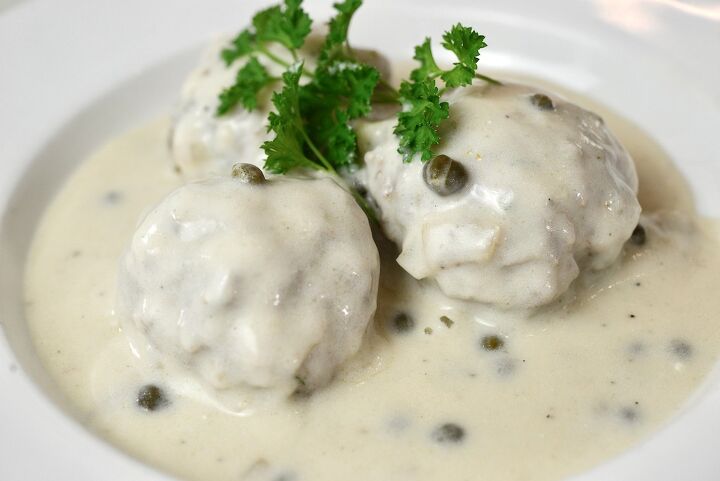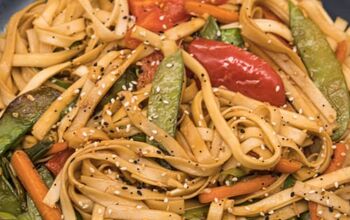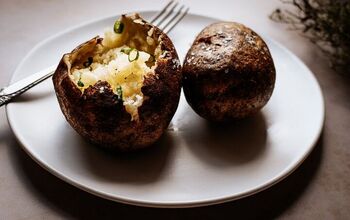These Delicious Königsberger Klopse Are a Classic German Dish of Tend

-
These delicious Königsberger Klopse are a classic German dish of tender meatballs in a delicate white sauce with capers.
Königsberger Klopse is one of those classic dishes that you will find at most German restaurants. Not only that, it is so easy to make that many Germans serve this at home.
This was certainly the case for me. Königsberger Klopse was one of my favorite dishes when I was a kid growing up in Germany.
In a way, it is a quintessential German dish. Did you know that Germans love slathering their main protein in plenty of sauce? These meatballs are just one example of that. They should be swimming in the sauce …
This post contains affiliate links, which means I make a small commission at no extra cost to you. You can read my full disclosure here.
Why you will love this recipe
“Königsberger” as we often call them as it is shorter, is really German comfort food. Originally, the meat was veal but I usually make this dish with grass-fed ground beef from a local farm. With onions and soaked bread, these meatballs become very tender and light.
What better way to serve them than with a delicious and light yet creamy sauce. While the capers are essential to this recipe, they ultimately are optional – should you not be a big fan of capers.
Even though it may look like a complicated recipe, it actually is very easy to make. Once you have made this a few times, you will love how quickly you can whip this up.
Whether you serve it for a weeknight dinner or for a special occasion, Königsberger Klopse are always a hit. They will surely impress your family and dinner guests!
What are the ingredients for these Königsberger Klopse
One of the reasons that this recipe is so easy is because you will not need any special ingredients.
- meat: this is the main ingredient. Traditionally, people have been using veal but as I said above, I use mostly ground beef. Since it is such a central ingredient, I always recommend getting the best quality you can afford. For us, that is grass-fed beef from a local farm.
- onions: there are quite a lot of onions in this recipe for good reason. They add to the flavor but also make the meatballs a bit lighter.
- stale bread: this is another key ingredient that make these German meatballs a bit fluffier. Typically, Germans use a stale breakfast roll. Since they can hard to come by here in the US, I have used a piece of French baguette or artisan bread.
- milk: to soften the bread, we will soak the bread in a bit of milk.
- egg: the egg is critical to make the meatballs both stick together and fluffy.
- chopped parsley: it will be hard to taste the parsley but it gives the meatballs nice green specks of color
- broth: we will cook the Königsberger Klopse in a broth or bouillon. Once they are cooked, this broth is the base for the sauce
- butter and flour: we will use these to thicken the sauce. Essentially, this is a roux or “Mehlschwitze”, as we call it in German.
- lemon juice: this ingredient gives the sauce its bright flavor that is so typical for Königsberger Klopse.
- sour cream: while many people use regular sweet or whipping cream, I always prefer using sour cream. I find that the latter gives the sauce a better, more complex flavor while also being a bit healthier (since it is fermented).
- sugar: while I am not a fan of unnecessarily making dishes sweeter than they need to be, the sugar here in this recipe rounds out the taste of the sauce. You can certainly adjust the amount to your liking!
- capers: I love capers as they are the distinct ingredient that makes these meatball Königsberger Klopse.
Useful tools and equipment
Here are a few tools and pieces of equipment that will help you in making this dish:
- 5 quart stainless steel pot: for me this is the perfect size pot for this recipe. Obviously, if you were to double the recipe you would need a bigger pot. This pot also works great for making the sauce and reheating the meatballs.
- Wire whisk: one of the “secrets” to making a creamy sauce is having a good wire whisk. This one is long enough not to fall into your pot if you lean it against its side.
- Stainless steel slotted spoon: you can certainly remove the meatballs from the bouillon any way you like but I find that a slotted spoon is the perfect equipment here. Once you own one, you will find many more uses for it in your cooking!
- Strainer: I like a stainless steel strainer as I am weary of using plastics and hot liquids. This one will perfectly do the trick!
How to make the Königsberger Klopse
How to make the meatballs
- Cut the stale bread into small cubes. In a small bowl, combine about ½ cup of milk with the bread cubes to soak. Set aside.
- Finely chop the onions and add them to a medium-sized bowl. Finely chop the parsley and add it to the same bowl. Crack the egg right into the bowl. When softened, take your hands to squeeze excess milk from the bread cubes and add them to the bowl. Add the ground meat to the bowl. With your hands, mix all the ingredients until well combined.
- Depending on your preference, with your hands form 8-16 meatballs. Place them on a plate and set aside.
- In a medium-sized pot, heat up about 1 quart of bouillon or stock.
- When the bouillon is boiling, carefully add the meatballs, cover, and turn to a low simmer.
- Simmer the meatballs for about 10 minutes or until done, turning them halfway through.
- With a slotted spoon, remove the meatballs from the pot, place them on a plate and set them aside.
- Strain the cooking liquid through a strainer and reserve for the sauce.
Making the creamy white sauce with capers
- Over medium-low heat, in the same or another medium-sized pot, melt 2-3 tablespoons of butter.
- Add about 2-3 tablespoons of flour. With a wire whisk, combine the butter and flour well.
- While stirring constantly, gradually add the reserved broth. Gently simmer to thicken the sauce.
- Turn off the heat. Add 1 tablespoon of lemon juice, ½ cup of sour cream, 1 teaspoon of sugar, and season with salt, and pepper.
- Taste the sauce and adjust seasonings to your liking.
Gently transfer the meatballs to the pot with the sauce and reheat over low heat.
These Königsberger Klopse are best over boiled potatoes. But you can serve them over rice, pasta, dumplings, or your favorite sides.
Can you make the Königsberger Klopse ahead of time?
Yes!
You can easily keep these German meatballs in the refrigerator for 4-5 days. When reheating, make sure to use low heat and don’t boil them.
If you want to keep them longer, you can freeze the Königsberger Klopse as well. I recommend freezing the meatballs separate from the sauce. When ready, simply reheat them gently over low heat in the sauce. It is best not to boil them again.
You see that you can easily make them ahead of time and have dinner ready in 15-25 minutes.
Königsberger Klopse substitutions and variations
Here are a few ideas about how to find substitutions or variations:
- the meat: while veal or beef is the traditional ingredient, you could also use ground pork, chicken, or turkey.
- onions: I always use chopped raw onions for this recipe – and so has my mom. If you like the crunch of the onions, you can chop them a little more coarsely. However, if you don’t like them to stand out, you can chop them very finely. Some people prefer sauteeing their chopped onion before adding it to the meat. In that case, they will be much softer but it adds one more step to this recipe.
- sour cream: as I mentioned above, I prefer using sour cream. However, you can perfectly use regular heavy cream in this recipe. Just note that you might need a little less sugar then.
- capers: for me, these German meatballs wouldn’t be Königsberger Klopse without capers. If you are not a big fan of them, you can always use a little less or omit them entirely. You can also add them to the sauce but strain them out right before serving. That way you get the distinct taste of the capers in the sauce without actually eating them.
- bread: if you can’t find a German breakfast roll or French baguette, you can also use breadcrumbs. If using them, you will also soak them in a bit of milk. You want them moist but not soggy.
- milk: soaking the bread in milk is certainly the preferred liquid to use. In a pinch, you could use water. However, you can perfectly substitute plant-based milk for the cow’s milk.
- parsley: the parsley here is mostly for little specks of color. So you can omit it if you don’t have it. I love using fresh chopped parsley but you could use dried parsley as well. Alternatively, you could use chopped chives.
Other German recipes you might like
Authentic Schnitzel
Classic German Rouladen
Authentic German Potato Salad
European Whole-Grain Bread
Authentic German Pretzels
Shop this post:
5-quart stainless steel pot: https://amzn.to/3H49ZxB
Wire whisk: https://amzn.to/3KDs5bX
Stainless steel slotted spoon: https://amzn.to/3KEo5rM
Strainer: https://amzn.to/3FYqDxa
Let me know if you have any questions or comments!
Pin For Later:
These Delicious Königsberger Klopse Are a Classic German Dish of Tend
Recipe details
Ingredients
- 1 pound ground beef
- 1 whole breakfast roll, piece of baguette or other bread
- 2 small onions
- 1 whole egg
- 1 TBSP parsley
- 1 quart bouillon, stock, or broth
- 2-3 TBSP butter
- 2-3 TBSP flour
- 1 TBSP lemon juice
- 1/2 cup sour cream
- 1 tsp sugar
- 1-2 TBSP capers, drained
- salt & pepper to taste
Instructions
- Cut the stale bread into small cubes.
- In a small bowl, combine about ½ cup of milk with the bread cubes to soak. Set aside.
- Finely chop the onions and add them to a medium sized bowl.
- Finely chop the parsley and add it to the same bowl.
- Crack the egg right into the bowl.
- When softened, take your hands to squeeze excess milk from the bread cubes and add them to the bowl.
- Add the ground meat to the bowl. With your hands, mix all the ingredients until well combined.
- Depending on your preference, with your hands form 8-16 meatballs.
- Place them on a plate and set aside.
- In a medium sized pot, heat up about 1 quart of bouillon or stock. When the bouillon is boiling, carefully add the meat balls, cover, and turn to a low simmer.
- Simmer the meatballs for about 10 minutes or until done, turning them half way through.
- With a slotted spoon, remove the meatballs from the pot, place on a plate and set aside.
- Strain the cooking liquid through a strainer and reserve for the sauce.
- Over medium-low heat, in the same or another medium sized pot, melt 2-3 tablespoons of butter. Add about 2-3 tablespoons of flour. With a wire whisk, combine the butter and flour well.
- While stirring constantly, gradually add the reserved broth. Gently simmer to thicken the sauce.
- Turn off the heat. Add 1 tablespoon of lemon juice, ½ cup of sour cream, capers, 1 teaspoon of sugar, and season with salt and pepper.
- Taste the sauce and adjust seasonings to your liking.
- Transfer the meatballs to the pot with the sauce and heat gently over low heat.
- For the classic pairing serve with boiled potatoes. You can also serve the meatballs over rice, pasta, dumplings, or your favorite side.



























Comments
Share your thoughts, or ask a question!
I see the capers in the ingredients. When are they added?
What type of bouillon or broth is used? Would the sauce still turn out white if using beef bouillon/broth?